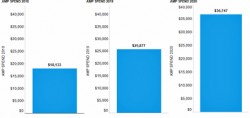This MGI Forecast provides a quantitative estimate of the total addressable market (TAM) for Agile Monetization Platform software from 2016 to 2020.
Included in this report are world-wide annual estimates of spending, growth rate (with detailed breakdown by AMP categories, geographies, and economic sectors), analysis of market size based on company size, impact of Internet of Things (IoT), Digital Transformation, and growth and technology spend profiles among others. The research report includes estimates and annual forecasts for cloud-based software products covering agile billing, configure-price-quote (CPQ), e-commerce, customer service, contract management, revenue recognition, order management, customer support, and mediation. The report is based on data from almost 35,000 companies in 116 countries and 66 industries across all major economic sectors. The data contained in this report is also available separately through an interactive Global Analytics Model tool available from MGI Research by subscription. Contact MGI Research at gam@mgiresearch.com for additional information.
The market for Agile Monetization Platform (AMP) software represents a new, large (and expanding), all-season opportunity with a total addressable market (TAM) of over $102 billion over the five years from 2016 to 2020 and beyond. MGI Research expects AMP spending to rise from $8.5 billion in 2016 to near $36.75 billion in 2020. The shift to new business models that are in large part based on recurring and/or usage-based pricing schemes, together with the increased impact from adoption of Internet of Things (IoT), will be key in driving AMP adoption. Leading organizations primarily in North America are already making the move to AMP today, and they comprise the bulk of the spending currently underway. Over the next 24 months, geographic markets beyond North America will accelerate, and fast-following firms and middle-of-the-road organizations in North America will ramp up their spending on AMP. Given the critical nature of AMP—it affects topline growth, profitability, and customer satisfaction—it is an area of technology spend that is being prioritized. This report details the sectors and vertical industries that are most impacted by major trends like IoT (“Internet of Things”) and the adoption of subscription business models.
Fueled by the Digital Revolution, the very nature of competition today is changing radically. Product innovation and growth opportunities are bound only by the imagination. Previously protected pools of profit are now at risk. Product cycles and market opportunities come and go in less than five years—with the majority of benefits accruing to a limited few. Organizations of all sizes want greater transparency and control in their business relationships. The demand for custom pricing models and flexible terms is counterbalanced by the challenges of delivering these capabilities at scale. Across most key world economies, the number and complexity of regulatory and audit requirements are mounting while the timeframes to reach compliance are getting shorter. Against this rapidly accelerating backdrop, product innovation and revenue optimization are the critical levers for growth and profitability. In the face of these opportunities and threats, progressive organizations are focusing on key processes and new monetization tools to sharpen their edge.
Increasing regulation, digital disruption, activist investors, and ever-pressing customer needs are pushing legacy IT systems and processes beyond their capacities to respond. Individuals and businesses alike now seek to consume services, not just products, and their preferences for pricing models and payment modalities are changing. Subscriptions, demand-based price models, pay-per-use, and increasingly complex enterprise agreements with a litany of unique entitlements now are the norm. Technology disruption accelerates the demand for these new pricing models, and it is everywhere—from the Internet of Things (“IoT”), autonomous vehicles, and artificial intelligence to digital disrupters like Netflix, Airbnb, and Uber. Neither the corner store nor the Fortune 10 companies are immune to this revolution. Reacting to these new business needs, organizations are looking to revamp their core business systems, particularly in the area of monetization.
Monetization is how efficiently and effectively market demand is created and translated into revenue, profits, and competitive differentiation.
The process of monetization reaches across the organization through product development, marketing, sales, finance, billing, and even customer support. Monetization is not a single product but a business discipline that combines business processes, tools, and skilled human resources to efficiently and effectively create and translate market demand into revenues, profits, and competitive differentiation. The term Agile Monetization was introduced by MGI Research in 2015 and originally evolved from a concept of Agile Billing pioneered by MGI Research in late 2013. In the monetization context, agility refers to the ability to create and evolve new offers by iterating rapidly, thus accelerating the velocity with which a business can bring new product offers to market.
The full report is available to MGI Research subscribers.


